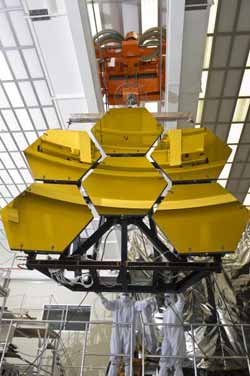NASA's James Webb Space Telescope completes first round of cryogenic mirror test

Engineers and technicians guide six James Webb Space Telescope’s mirror segments off the rails after completing final cryogenic testing this week at Marshall. Credit: (NASA/Emmett Given)<br>
The ten week test series included two tests cycles where the mirrors were chilled down to -379 degrees Fahrenheit, then back to ambient temperature to ensure the mirrors respond as expected to the extreme temperatures of space.
A second set of six mirror assemblies will arrive at Marshall in late July to begin testing, and the final set of six will arrive in the fall.
The X-ray and Cryogenic Facility at NASA's Marshall Space Flight Center in Huntsville, Ala. provides the space-like environment to help engineers measure how well the telescope will image infrared sources once in orbit.
Each mirror segment measures approximately 4.3 feet (1.3 meters) in diameter to form the 21.3 foot (6.5 meters), hexagonal telescope mirror assembly critical for infrared observations. Each of the 18 hexagonal-shaped mirror assemblies weighs approximately 88 pounds (40 kilograms). The mirrors are made of a light and strong metal called beryllium, and coated with a microscopically thin coat of gold to enabling the mirror to efficiently collect infrared light.
The telescope is a combined project of NASA, the European Space Agency and the Canadian Space Agency. Northrop Grumman is the prime contractor under NASA's Goddard Space Flight Center in Greenbelt, Md. Ball Aerospace & Technologies Corp. in Boulder, Colo., is responsible for mirror development. L-3- Tinsley Laboratories Inc. in Richmond, Calif. is responsible for mirror grinding and polishing.
Media Contact
More Information:
http://www.nasa.govAll latest news from the category: Physics and Astronomy
This area deals with the fundamental laws and building blocks of nature and how they interact, the properties and the behavior of matter, and research into space and time and their structures.
innovations-report provides in-depth reports and articles on subjects such as astrophysics, laser technologies, nuclear, quantum, particle and solid-state physics, nanotechnologies, planetary research and findings (Mars, Venus) and developments related to the Hubble Telescope.
Newest articles

A universal framework for spatial biology
SpatialData is a freely accessible tool to unify and integrate data from different omics technologies accounting for spatial information, which can provide holistic insights into health and disease. Biological processes…

How complex biological processes arise
A $20 million grant from the U.S. National Science Foundation (NSF) will support the establishment and operation of the National Synthesis Center for Emergence in the Molecular and Cellular Sciences (NCEMS) at…

Airborne single-photon lidar system achieves high-resolution 3D imaging
Compact, low-power system opens doors for photon-efficient drone and satellite-based environmental monitoring and mapping. Researchers have developed a compact and lightweight single-photon airborne lidar system that can acquire high-resolution 3D…





















